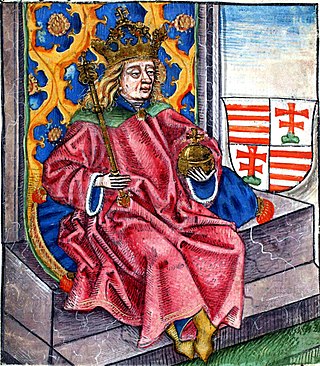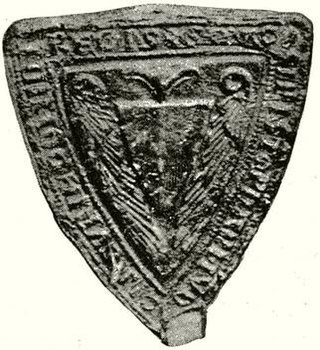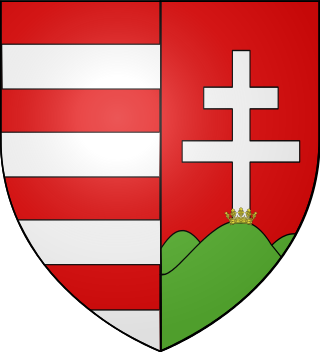
The thirtieth or thirtieth customs (Hungarian : harmincad, Croatian : tridesetnica, Latin : tricesima) was a tax on foreign trade in the Kingdom of Hungary.

The thirtieth or thirtieth customs (Hungarian : harmincad, Croatian : tridesetnica, Latin : tricesima) was a tax on foreign trade in the Kingdom of Hungary.
A charter that Andrew II of Hungary issued for the Benedictine Lébény Abbey in 1208 preserved the earliest reference to the thirtieth. [1] According to the charter, wine and foodstuffs delivered for the monks and their guests were exempt from all tolls and the thirtieth at Győr and on the bridges of the rivers Rába and Rábca. [2] Royal revenue from the thirtieth amounted at 1,500 marks when Andrew II granted it to his daughter, Yolanda in 1235. [3]
According to a scholarly theory, the granting of customs and tolls to ecclesiastic institutions from the late 12th century gave rise to the collection of the thirtieth, because it represented the part of the revenues that the kings preserved for themselves or for their queens. [4]

Stephen V was King of Hungary and Croatia between 1270 and 1272, and Duke of Styria from 1258 to 1260. He was the oldest son of King Béla IV and Maria Laskarina. King Béla had his son crowned king at the age of six and appointed him Duke of Slavonia. Still a child, Stephen married Elizabeth, a daughter of a chieftain of the Cumans whom his father settled in the Great Hungarian Plain.

Béla IV was King of Hungary and Croatia between 1235 and 1270, and Duke of Styria from 1254 to 1258. As the oldest son of King Andrew II, he was crowned upon the initiative of a group of influential noblemen in his father's lifetime in 1214. His father, who strongly opposed Béla's coronation, refused to give him a province to rule until 1220. In this year, Béla was appointed Duke of Slavonia, also with jurisdiction in Croatia and Dalmatia. Around the same time, Béla married Maria, a daughter of Theodore I Laskaris, Emperor of Nicaea. From 1226, he governed Transylvania as duke. He supported Christian missions among the pagan Cumans who dwelled in the plains to the east of his province. Some Cuman chieftains acknowledged his suzerainty and he adopted the title of King of Cumania in 1233. King Andrew died on 21 September 1235 and Béla succeeded him. He attempted to restore royal authority, which had diminished under his father. For this purpose, he revised his predecessors' land grants and reclaimed former royal estates, causing discontent among the noblemen and the prelates.

The Golden Bull of 1222 was a golden bull, or edict, issued by Andrew II of Hungary. King Andrew II was forced by his nobles to accept the Golden Bull (Aranybulla), which was one of the first examples of constitutional limits being placed on the powers of a European monarch. The Golden Bull was issued at the year 1222 diet of Fehérvár. The law established the rights of the Hungarian nobility, including the right to disobey the King when he acted contrary to law. The nobles and the church were freed from all taxes and could not be forced to go to war outside of Hungary and were not obligated to finance it. This was also a historically important document because it set down the principles of equality for all of the nation's nobility. Seven copies of the edict were created, one for each of the following institutions: to the Pope, to the Knights Templar, to the Knights Hospitaller, to the Hungarian king itself, to the chapters of Esztergom and Kalocsa and to the palatine.
The ispán or count, deriving from title of župan, was the leader of a castle district in the Kingdom of Hungary from the early 11th century. Most of them were also heads of the basic administrative units of the kingdom, called counties, and from the 13th century the latter function became dominant. The ispáns were appointed and dismissed by either the monarchs or a high-ranking royal official responsible for the administration of a larger territorial unit within the kingdom. They fulfilled administrative, judicial and military functions in one or more counties.

The Voivode of Transylvania was the highest-ranking official in Transylvania within the Kingdom of Hungary from the 12th century to the 16th century. Appointed by the monarchs, the voivodes – themselves also the heads or ispáns of Fehér County – were the superiors of the ispáns of all the other counties in the province.

Denis (II) from the kindred Türje or nicknamed Denis the Big-nosed was a powerful Hungarian baron, landowner and military leader in the first half of the 13th century, who held several secular positions during the reign of kings Andrew II and Béla IV. Denis was a childhood friend and staunch supporter of the latter throughout his life. He was the most notable member of the gens Türje.

The high-medieval Kingdom of Hungary was a regional power in central Europe. It came into existence in Central Europe when Stephen I, Grand Prince of the Hungarians, was crowned king in 1000 or 1001. He reinforced central authority and forced his subjects to accept Christianity. Although all written sources emphasize only the role played by German and Italian knights and clerics in the process, a significant part of the Hungarian vocabulary for agriculture, religion was taken from Slavic languages. Civil wars and pagan uprisings, along with attempts by the Holy Roman emperors to expand their authority over Hungary, jeopardized the new monarchy. The monarchy stabilized during the reigns of Ladislaus I (1077–1095) and Coloman (1095–1116). These rulers occupied Croatia and Dalmatia with the support of a part of the local population. Both realms retained their autonomous position. The successors of Ladislaus and Coloman—especially Béla II (1131–1141), Béla III (1176–1196), Andrew II (1205–1235), and Béla IV (1235–1270)—continued this policy of expansion towards the Balkan Peninsula and the lands east of the Carpathian Mountains, transforming their kingdom into one of the major powers of medieval Europe.
Ampud, also Ampod, Apod or Ompud was a powerful aristocrat in the Kingdom of Hungary in the second half of the 12th century. He was Ban of Slavonia between 1163 or 1164 and 1171 or 1174, and Palatine of Hungary from around 1164 till around 1176.
Mikó was a Hungarian prelate in the twelfth century. He was Archbishop of Kalocsa between around 1156 and 1165. He crowned two Hungarian monarchs, Ladislaus II and Stephen IV king, because Lucas, Archbishop of Esztergom, who considered them as usurpers, had denied to perform the ceremony.
Denis, son of Ampud, also Denis, son of Apod, was an influential baron in the Kingdom of Hungary in the first decades of the 13th century. He was Master of the treasury between 1216 and 1224. He was also ispán of at least three counties.

Stephen (I) from the kindred Ákos was an influential baron in the Kingdom of Hungary in the late 13th century and the early 14th century. He was born into an ancient Hungarian clan. He was a staunch supporter of Andrew III of Hungary. He served as Judge royal between 1298 and 1300, and Palatine of Hungary from 1301 to 1307.
Mojs, also Moys or Majos was a Hungarian noble, who served as Palatine of Hungary between 1228 and 1231, during the reign of Andrew II.

Stephen (I) from the kindred Gutkeled was a Hungarian influential lord, an early prominent member of the gens Gutkeled and ancestor of its Majád branch. He governed the Duchy of Styria on behalf of claimants Duke Béla and Duke Stephen from 1254 until his death.

The royal treasurer, or simply treasurer, also royal purse-bearer, was an official in the Hungarian royal court, existed around from the 1320s to the 16th century. The position evolved from the royal dignity of Master of the treasury, which gradually adopted more and more judiciary functions over the centuries, thus the newly established royal treasurer put in charge of collecting and administering royal revenues in practice.
Paul from the kindred Szécs, also known as Paul of Komárom, was a Hungarian nobleman and landowner who was lord of Komárom from the 1280s. He came to prominence during the last regnal years of Andrew III of Hungary.
George from the kindred Baksa was a Hungarian lord and a distinguished military leader in the second half of the 13th century. He was a key supporter of Ladislaus IV of Hungary and participated in various military campaigns during his reign. He successfully fought against the Mongols in Hungary and Poland. After granting large-scale domains in Upper Hungary, he was also known as George of Sóvár or George the Salty and became eponymous progenitor of the Sós de Sóvár noble family.
The oath of Bereg, also labelled as agreement at Bereg, was a treaty signed between the Kingdom of Hungary and the Holy See in the forests of Bereg on 20 August 1233. In the document, King Andrew II of Hungary vowed that he would not employ Jews and Muslims to administer royal revenues, which caused a decade-long discord with the Holy See starting in the early 1220s, composing of diplomatic complaints and ecclesiastical censures. The document is also an important source for the history of salt trade in Hungary.
Simon (I) Nagymartoni was an Aragonese-born Hungarian knight and diplomat in the first half of the 13th century. He and his siblings settled down in Hungary, where the family integrated into the social elite. Simon was a faithful confidant of kings Andrew II and Béla IV.
Mika the Bearded was a Hungarian nobleman at the turn of the 12th and 13th centuries, who served as ispán of Bihar County three times during the reign of King Andrew II of Hungary.
Paschasius was a Hungarian Catholic prelate in the 13th century, who served as Bishop of Nyitra from 1285 to at least 1297.